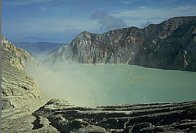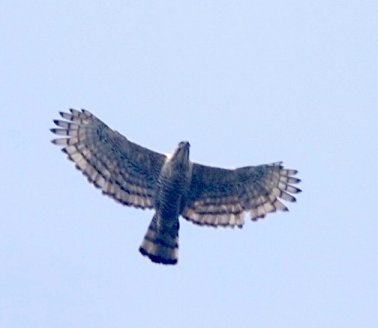|
Ijen, East Java; 8°3.5' S, 114°14.5' E, consists of a group of small
strato-volcanos, within
the 20 km Ijen (Kendeg) caldera.
The northern volcano-wall is a typical ridge, while the rest of the
craterwall is covered by older volcanoes,
including Gunung Merapi, which reaches 2.799 m asl, and are the highest
in the Ijen-complex.
This is, however, not the same at the much more active
Merapi-volcano in the central part of Java..

Gunung
Merapi at2.799m asl. Behind the ridge to the right is the Ijen Craterlake.
Just west of Gunung Merapi, we find the famous Kawah
Ijen volcanon, which has an almost
1 km wide sulphourous turqouise-colored craterlake.
The walls around reaches 200m up, and the lake itselv 200 m deep.

Sulfurmining-workers,
left on the picture, scrapes sulfur from the crater-walls, og bring
it down to the
industry in Jambu, near Banyuwangu.
6 small moderate phreatic
eruptions has come from Ijen during the last 100 years..
Wednesday,
December 21st, 2011
On the 18th of December, alert level at Ijen was raised from 2 to 3
on a scale from 1 to 4.
Visual observations on the 17th showed that the colour of the lake has
changed to white. The smell of sulfur is
strong, and it has been difficult to measure the temperature in the
lake, which on the 14th was 34° C.
The seismic activity has also raised during December.
Please look into our web-camera page
and if you do see changes, please copy the picture and let us know!
E-mail address below.
Bildene, og en del
tekst denne side: Photo
and some text this page:
Kimberly, P., Siebert,
L., Luhr, J.F., and Simkin, T. (1998). Volcanoes of Indonesia, v. 1.0
(CD-ROM).
Smithsonian Institution, Global Volcanism Program, Digital Information
Series, GVP-1.
A STORY BEHIND
After three major eruptions 3,500 years ago that created a caldera measuring
22 by 25 kilometers, the Ijen volcano rose to world fame for its crater
lake with the most acidic water in the globe.

Against
the risk: Mining activities are seen in the famous Ijen crater in Bondowoso,
East Java.
The Ijen volcano rose to world fame for its crater lake with the most
acidic water in the globe.
Photo by JP/Indra Harsaputra
Looming behind the natural beauty and geothermal energy potential of the
Ijen crater or Kawah Ijen, however,
is a threat to millions of people settling around the East Java volcano.
At also has a very large sulfur mining activity. Miners were carrying
75-90 kilograms (kg) of sulfur, covering a distance
of 300 meters from the bottom of the crater to its rim, with a gradient
of 45 to 60 degrees. They have to do it for hours
without wearing masks.
Once out of the crater, the workers still had to carry their sulfur
chunks three kilometers (km) from Ijen’s summit
to the Paltuding valley to get paid. The sulfur they mine is eventually
sold on to cosmetic firms.
With about 200 miners operating in the crater each day, the sulfur they
extract reaches 14 tons daily.
According to the Volcanology and Geological Disaster Mitigation Center
(PVMBG), the amount of sulfur
being mined is only 20 percent of the total potential in the Ijen crater.
Such traditional mining, also found on
Mount Welirang in East Java, is only found in Indonesia. Situbondo and
Banyuwangi.
The Ijen crater boasts a magnificent crater lake, which
is over 182 meters deep and has 32 million cubic meters
of beautiful turquoise green water. The high acidity of the water gives
it a unique, bitter flavor. The crater rim
encircles the lake, measuring 960 by 600 meters at its lower portion
and 1,600 by 1,160 meters and its top.
The crater area is also the habitat of Javan hawk-eagles, with a wingspan
of 150 centimeters (cm).
These hawk-eagles have a body length of 70 cm, and feature two crests
and mostly dark brown feathers.
This rare species was named the national bird in 1993 for having inspired
the creation of the national coat
of arms called the Garuda Pancasila.
Wildlife conservation activist Rosek Nursahid, also the founder of
ProFauna, said that a survey revealed only two Javan hawk-eagles remained
in the Ijen crater, while in 1996, 10 pairs of the species could still
be found.
“The drop in the eagle’s population has been due to forest
conversion into farmland and intensive use of pesticides, which disturbs
their reproduction,” he said. The other endemic animals are wild
boars, fowl and black monkeys.

Javan
Hawk-eagle “National Bird of Indonesia”
This photo belongs to Lip
Kee's photostream
License: Some
rights reserved
|
The Javan Hawk-Eagle, Nisaetus bartelsi (earlier
placed in Spizaetus) is a medium-sized, approximately
61 cm long, dark brown raptor in the family Accipitridae.
Its head and neck are rufous and it is heavily barred
black below. It has a long black crest with a white tip. The sexes
are similar. The young is duller and has
unmarked underparts.
An Indonesian endemic, the Javan Hawk-Eagle occurs in humid tropical
forests of Java. Its range in East
Java includes Sempu Island, Bromo Tengger Semeru National Park,
Meru Betiri National Park and
Alas Purwo National Park. It can also be seen in captivity in
zoos like Kebun Binatang Bandung.
The Javan Hawk-Eagle is believed to be monogamous.
The female usually lays one egg in a nest high on
top of a forest tree. The diet consists mainly of birds, lizards,
fruit bats and mammals.
http://en.wikipedia.org/wiki/Javan_Hawk-Eagle
|
 Live
hard, work hard: Miners carry sulfur from the bottom of the crater
Photo by JP/Indra Harsaputra
Live
hard, work hard: Miners carry sulfur from the bottom of the crater
Photo by JP/Indra Harsaputra
.
The Ijen volcanic zone is also a source of geothermal energy for power
generation. PT Medco Power Indonesia
planned to conduct a geothermal exploration in Kawah Ijen after a survey
pointed to the area’s potential to
generate 110 megawatts.
Several geologists have indicated dangers the volcano poses to the
local population. Primarily these dangers
are a result of the permeation of highly acidic crater water into other
water supplies rather than its volcanic activity.
On its way to the sea, the highly acidic water passes settlements, paddy
fields, plantations and sugar mills.
Based on research conducted by Soegijapranata Catholic University in
Semarang, Central Java in 2007,
the lake’s acidic water has polluted rivers and local people’s
wells. Consequently, the residents are facing
tooth and bone damage, while agricultural production is reduced.
The polluted water is still used to irrigate 3,564 hectares of paddy
fields, considerably affecting the lives
of millions of people in the vicinity of the Ijen volcano.
The above article: By Indra Harsaputra, The
Jakarta Post, Bondowoso, East Java | Mon, 12/19/2011 9:32 PM
http://www.thejakartapost.com/news/2011/12/19/kawah-ijen-between-potential-threat.html
| |
Linker:
|
|
|
Also visit our page with indonesian volcanoes!
|
|







